North Vietnam, 67th Birthday of Ho Chi Minh, May 19th, 1957 (Michel Nr. 57-60); While the official birth year of Ho Chi Minh, whose birth name was Nguyễn Sinh Cung, varies between 1890 to 1895, depending on the biography one reads, the Vietnamese post authorities settled on the earliest date of 1890 which would have made him 67 years in 1957. A set of four stamps was issued in the denominations of 20D, 60D, 100D and 300D. The lower values were most likely for printed matter and local postcards but the editor has never seen any from this time period making this only an educated guess. They may also represent add-on values to complete odd postage rates. The standard national letter rate was still 100D (it moved uo to 150 Dong by the end of the year) and the standard letter rate to China stood at 300D. The stamps were again produced at the Vietnamese National Bank Printing Works in sheets of 50 stamps each. Perforation was 13.0 but on the 300D Michel lists an alternative perforation of 10.0, which appears to be very rare.
This is a mint set in perforation 13.0.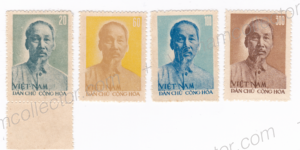
The most likely way to encounter used stamps is a set that was cancelled to order, like this one.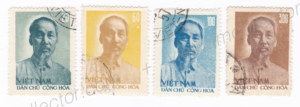
Here are two complete sheets canceled to order of the 20D and 60D values and a mint sheet of the 300D value. Note that the 300D stamp in position D5 shows the plate error “HCM with flat head”
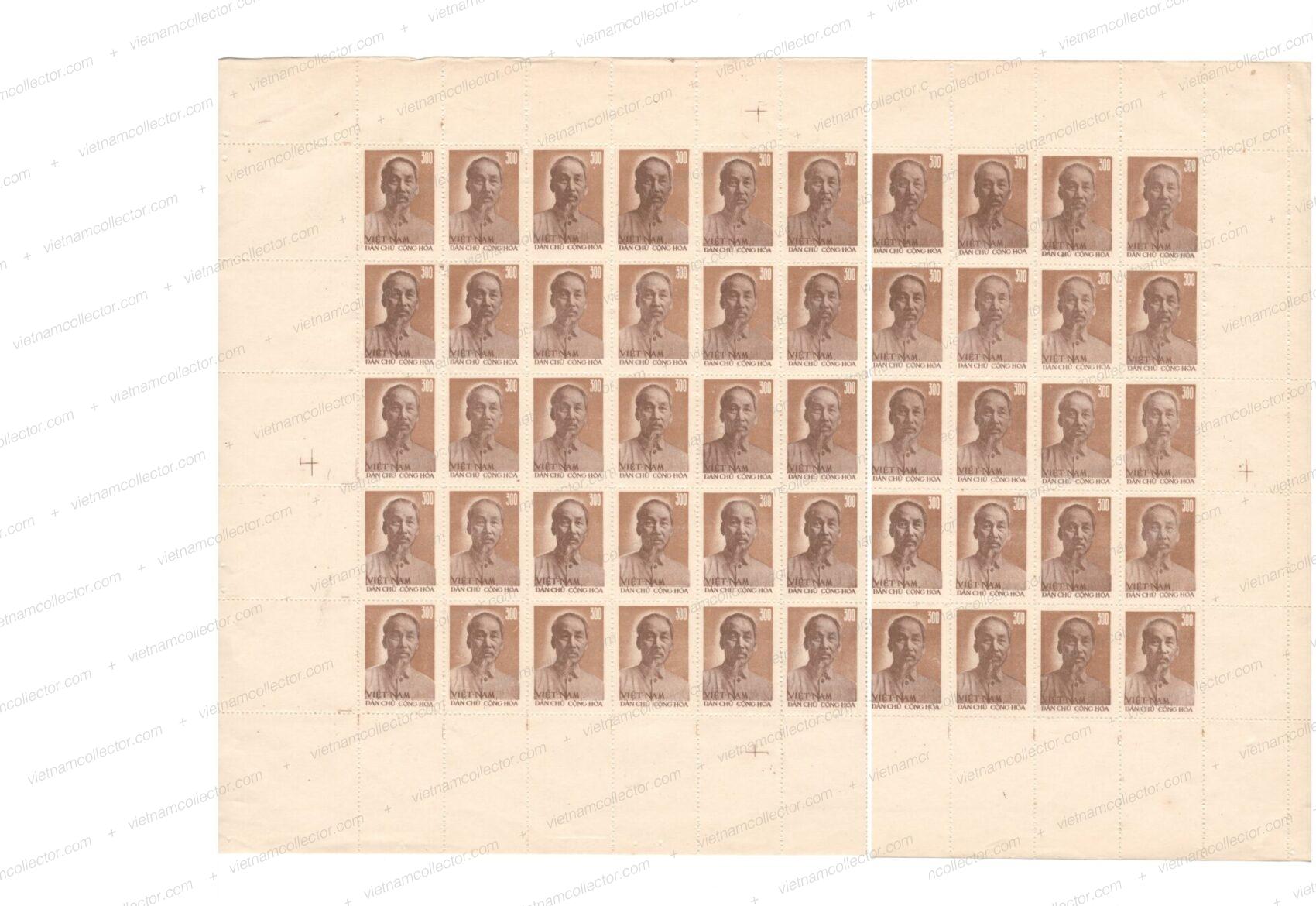
There is also a rare sheet confection on the 300D value. Normally the sheet margins on the side were pretty small (as can be seen on the two sheet samples above) but there are also sheets that show a stamp sized perforated field on the right sheet margin. It is not clear if this was caused by a perforation error (shifted perforation) or too wide paper margins. Below is a mint block of eight that shows the two empty fields on the right.
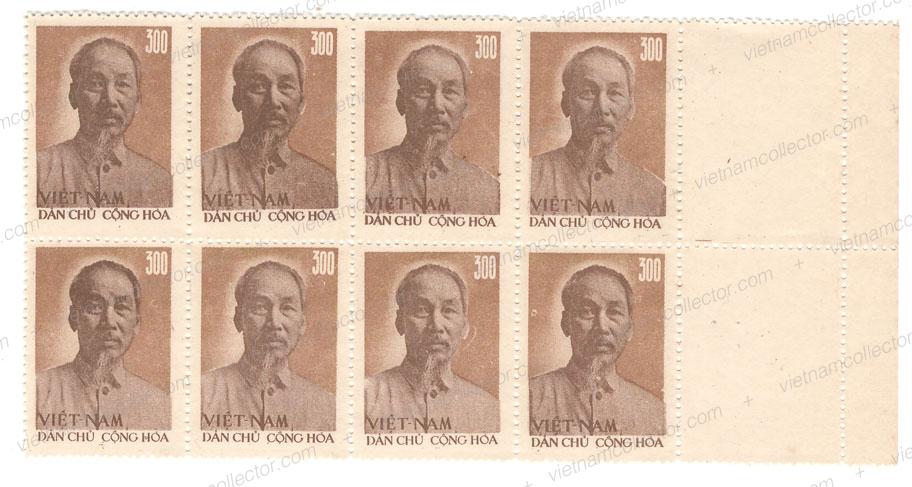
Postally used sets are harder to come by and they are valued at least four times as much as a CTO set.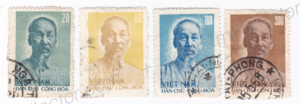
The 100 Dong value must have been produced in at least two different printings using different plates. The rarer printing shows a smaller “100” in the top right of the stamp. Here are mint, CTO and postally used samples of the smaller “100” printing. They are worth at least twice that of the larger “100” version. Note, the somewhat darker blue in the face of HCM which probably indicates a newer, less worn printing plate.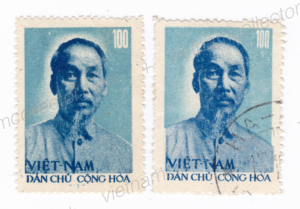
Here are two postally used pairs. The one on the top shows the large “100” and the one below the small “100”.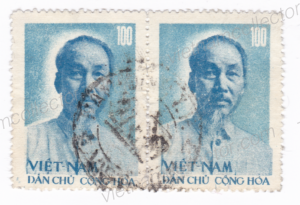
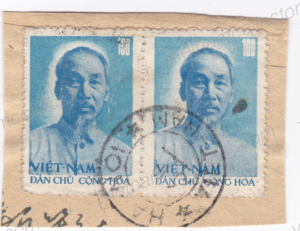
Heres is a rare color variety of the 300D stamp, postally used, that was printed in light-olive brown (according to the Michel Color Guide).
There is a re-occuring plate error on the 100 and 300 D value that shows HCM with a “flattened” head crown. It is located in position D5 on the sheet of 50 stamps. Below is a large block of 25 mint 300D stamp of which the most right stamp of the second row from the bottom that shows the plate error.
Detailed scan of the error stamp:
Here is a mint block of four of the 300D value that shows two plate errors. The top right stamp shows the “flattened crown” and the bottom right stamp shows “scars on HCMs forehead”.
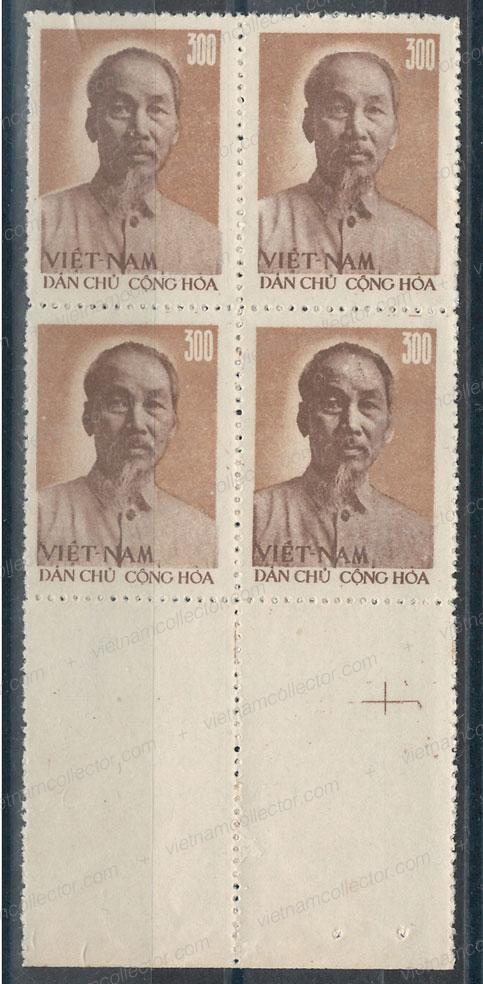
Detailed scans of the affected areas.
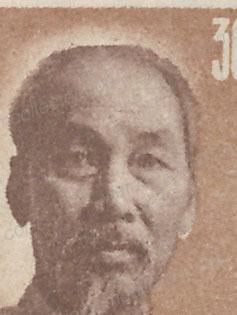
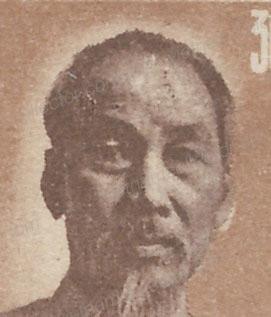
The Vietnamese Printing Works had not yet perfected the Offset printing method and so stamps with accidental printing flaws or smudges do occur frequently. Below is a pair of the 20D stamp mint. The top stamp shows a flaw that was caused by a small piece of debris that fell on the printing plate and that prevented color from being applied in its spot. HCM hence looks like he is waring an ear plug in the left ear.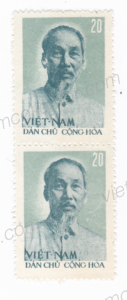
Here is a detailed view of the accidental error.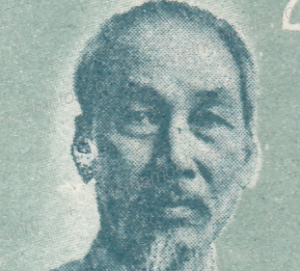
Perforation errors do occur. Below is a spectacular block of six of the small “100” variety that is completely imperforated vertically. 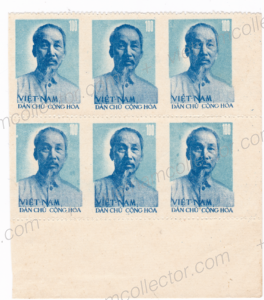
This the 300D value imperforated on the left.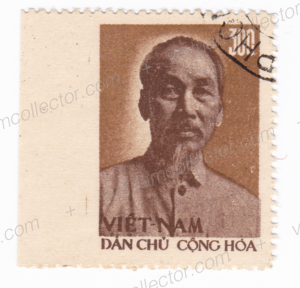
Letters with stamps of the series are available but by no means common. Letter from the Czechoslovakian Hospital in Hai Phong to a ministry in Prague, Czechoslovakia mailed a few days after the stamps were issued May 25th, 1957. The letter was marked to be sent “registered” but was sent standard airmail in the end. Franked with a pair of the 300D values and 50D of the Dien Bien Phu issue (orange yellow center) for a total of 650 Dong in postage.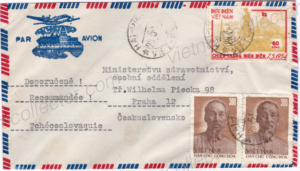
Here is the second letter featuring Block Nr. 2 (horizontal stripes) with a standard date canceller. The letter also features two 20D HCM Birthday stamps (in old currency) of which the left shows a plate error (white mark in left top corner) and one 12 xu GANEFO stamp. The HCM Birthday stamps were devalued by 1,000:1 which meant they were worth only 4xu at the time of mailing. The overall postage hence amounted to 26xu.
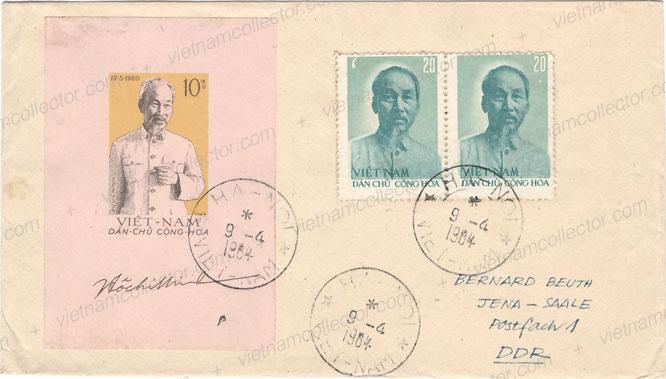
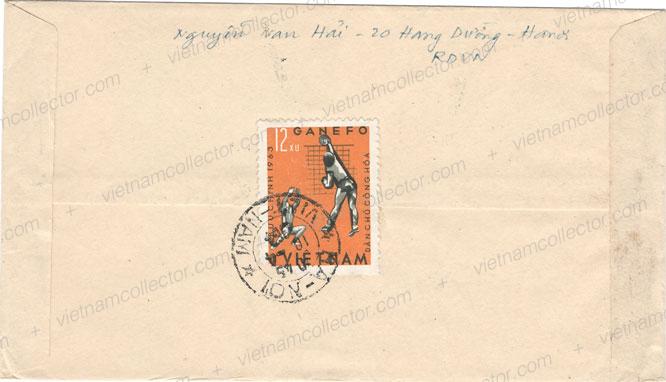
Here is the second letter that features the 10xu souvenir-sheet together with two 20D HCM Birthday stamps (in old currency) along with the 12 xu GANEFI stamp. The HCM Birthday stamps were devalued by 1,000:1 so were only worth 4 xu at the time of mailing. The overall postage hence amounted to 26xu.
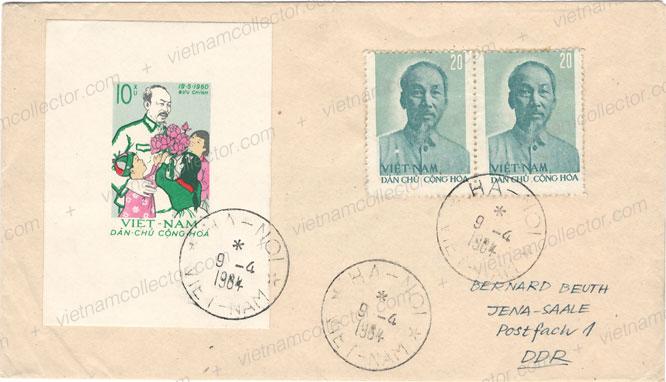
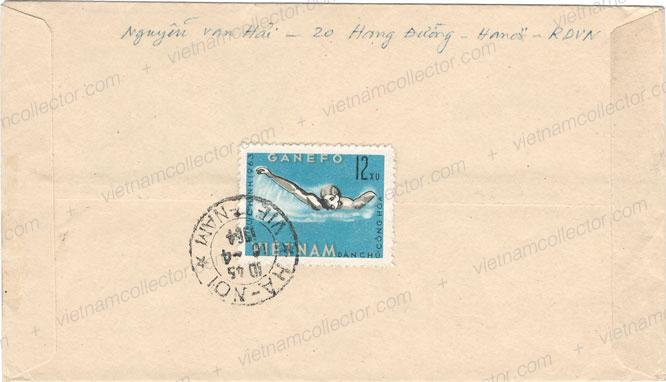
Mixed franking on a Xunhasaba printed matter bulletin mailing with official and standard postage stamps. The bulletin carries three of the 60D HCM stamps plus a 200D Official stamp (Defense of the Country) for an overall postage of 380D. The bulletin announces the military free frank from 1959 and the Vietnam Day stamp from the same year.
Interesting mixed currency franking of the 6xu Sluice value, together with the 12xu World Peace Conference and 20D HCM Birthday stamp. The 20D HCM stamp, which is hard to find on cover, was valued in Old Ding the were devalued by 1,000:1 on March 1st, 1959, which meant it was only worth 2xu at the time of mailing. The overall postage hence amounted to 20xu, which was the standard letter rate to fellow socialist countries as of April 15th, 1959.
Rare multiple franking of the 100D value paying the 200D postcard tariff to fellow Socialist countries. Mailed in April of 1959.
Letter to China from May of 1957 mailed with a pair of the 100D stamps (large “100”) and a single of the 200D cotton factory stamp for a total franking of 400D. Rectangular and circular Chinese censor stamps.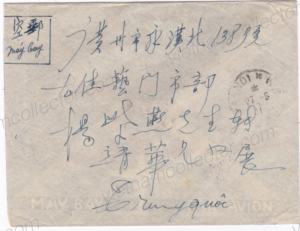
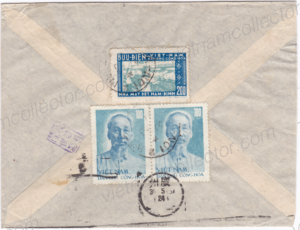
Multiple franking of the 100D value from June of 1957 paying the 300D surface letter rate to China.
Mixed franking of one 100D and one 300D value paying the 400D air mail letter rate to China (up to 10g weight). Red Chinese censor hand stamp on the reverse.
Mixed franking of two 300D HCM stamps plus the early NVN stamps on an air mail letter to Czechoslovakia for a total postage of 1,010 Dong. Mailed in August, 1957.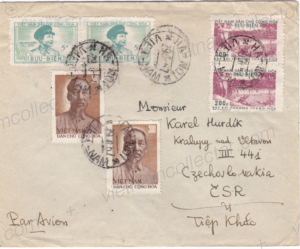
Mixed franking of the Textile Mill set (all values in Perf 13.0) together with the 300D HCM Birthday stamp paying an overall postage of 1,000D on an international air mail letter sent from Hanoi to East Germany in June of 1957. At that time the surface letter rate for the first 5g was 300D and the air mail surcharge 350D. So this letter must have been quite a bit heavier. The HCM Birthday stamp has an attached empty perforated field. Probably unique.
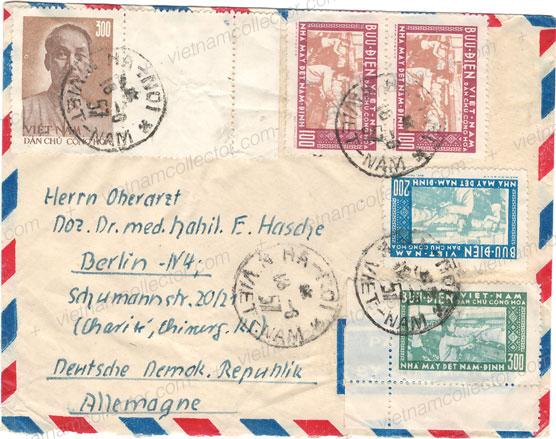
Mixed franking of the perforated 50D Dien Bien Phu stamp together with the 1,000D Return of the Government and 300D HCM Birthday stamps paying an overall postage of 1,350D on an international air mail letter sent in May of 1957 from Hanoi to East Germany. The postage paid is unusually high and may have reflected the registered air mail letter rate (300D base postage for 5g plus 350D Air Mail surcharge plus 600D Registration surcharge) or simply a very heavy letter that weighed well over the standard 5g.
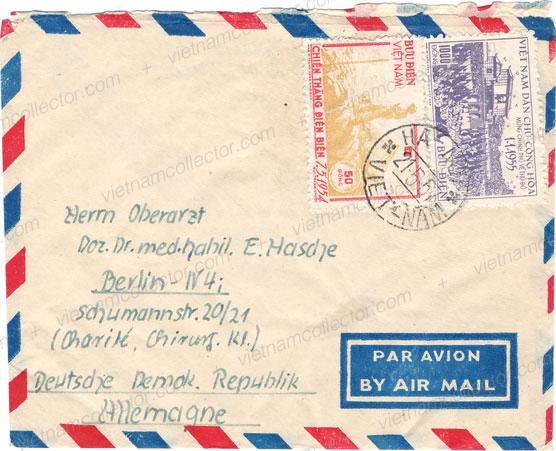
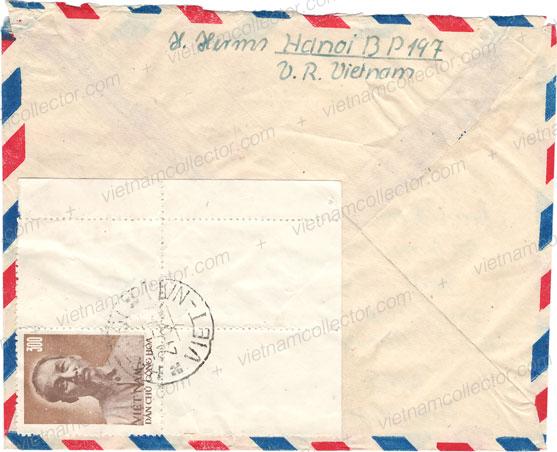
Mixed franking between normal stamps (including three of the 100D HCM stamps) and the complete set of the official Union Congress set on an envelope sent by a member of the East German Consulate to East Germany in February of 1958. The overall postage amounted to 1,100D.
Air mail letter mailed from Hanoi to Berlin, East Germany. Franked with a single 100D HCM (large number) and 300D plus other early NVN stamps for a total ranking of 1,000 Dong. Mailed in June, 1957.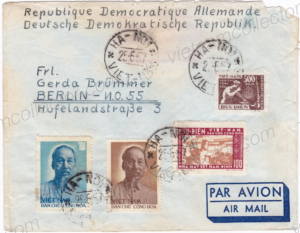
Two air mail letters to China both franked with a single 100D HCM and 300D HCM for total postage of 400D. Both letters must have been heavier than the standard 20g as they were franked 100D higher than the stand letter rate to China in force at the time. Rectangular Chinese censor cachet on the back.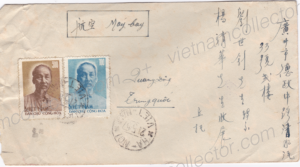
Single franking of the 300D value to China. Rectangular Chinese censor stamp on the reverse.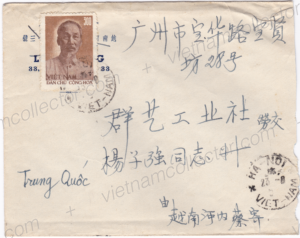
The same franking on an adversity letter made out of note paper to Hungary from August, 1957.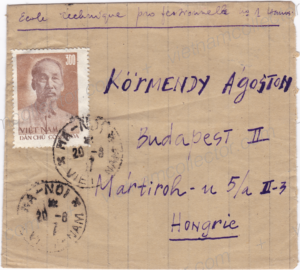
Very rare local adversity cover made from used note paper mailed from Nam-Dinh in December, 1957 to Chu Tuong Hue. The standard letter rate on November 1st, 1957 had risen to 150D made up of a single 100D HCM (small “100”) and a single 50D Dien Bien Phu (Orange-yellow center). Ex Klewitz/Schwirtz.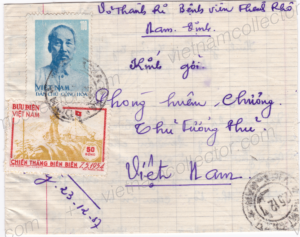
Letter dated December, 1958 from Hanoi to Prague, Czechoslovakia franked with single of the 100D HCM value and a single 100D stamp 12 years of the Republic. The 200D overall postage makes little sense though as the rate at the time was 300D. So this is either a postal error or the cover may represent a philatelic favor cancel.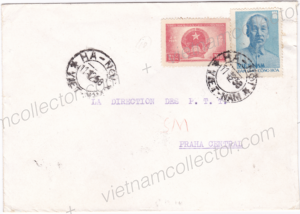
Colorful mixed franking on which the smaller 20D and 60D HCM values were used. They are rare to find on cover. Since the letter was mailed just one month after the currency devaluation in 1959 it carries a dual currency franking as follows: 250 Old Dong :1,000 = 0.25 New Dong (or 25 Xu) plus 5 Xu for total franking of 30 Xu. Sent on April 9th, 1959 to Czechoslovakia.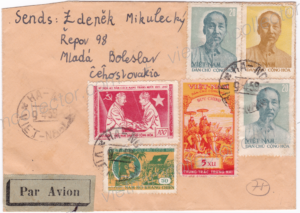
Rare regional letter (ex Schwirtz) sent from Hanoi to Sihanoukville in Cambodia from March of 1960. Since the letters weight (20g) is annotated on the envelope this letter documents that the standard air mail letter rate amounted to 60xu at the time (the two stamps in Old Dong had been devalued by 1,000:1 on March 1st, 1959). The addressee was unknown in Sihanoukville so the letter was stamped with “Unknown” and “Return to Sender” and then returned to Vietnam.
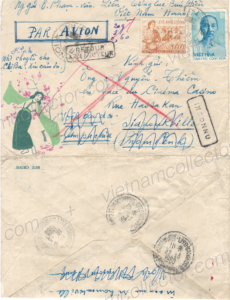
Mixed franking most likely from a member of the East German Consulate (which had access to official stamps) featuring a mix of regular stamps (including the rarer 60D HCM stamp) and two official Union Congress stamps (40D and 100D) for an overall postage of 1,740D. The letter was registered. The basic surface letter rate abroad amounted to 300D, the air mail surcharge to 350D (for every 5g) and the registration fee to 600D. So this letter must have weighed between 10-15g.
Rare Specimen/Printed Matter Xunhasaba mailing from March of 1964. The letter carries a mix of regular stamps (including the rarer 60D HCM issue) plus one of the 80D Official Union Congress stamps for an overall postage of 740D. England was still a rare destination in the early 1960’s.
Late usage rare registered letter of the three 300D HCM stamps. The 900 Old Dong represented 0.90 New Dong (or 90 Xu) plus 2 xu of the farm products series for a total franking of 92 Xu. Prague arrival cancel on the reverse.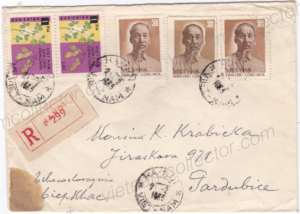
Very late usage of two of the 300 Dong HCM issue used in May of 1968 (which equalled 60 Xu) plus a 12 Xu of the 1963 Five Year Plan for a total franking of 72 Xu mailed to France.The left 300D stamp shows the plate error “brown dot in C in the word CHU”(Field A6).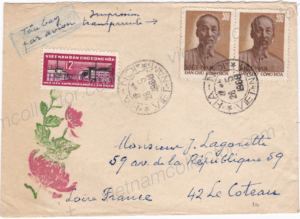
Mixed currency franking of the 6xu Medical Plant value together with other NVN stamps on a letter sent to the Soviet Union. The 100D HCM stamp was still denominated in Old Dong which were devalued by 1,000:1 on March 1st, 1960 so were only worth 10xu at the time of mailing. The overall franking amounted to 46xu.
Air Mail letter sent, most likely by member of the East German Embassy in Hanoi, to a relative in Muenster, West Germany in January of 1959. West Germany was a rare destination at that time. The letters is franked with a mixture of official stamps (three stamps from the Opening of Hanoi Stadium set) plus some general purpose stamps (from the Jade Tempe, HCM Birthday and Southern Resistance sets) paying an overall postage of 650D
Registration Nr. 100044

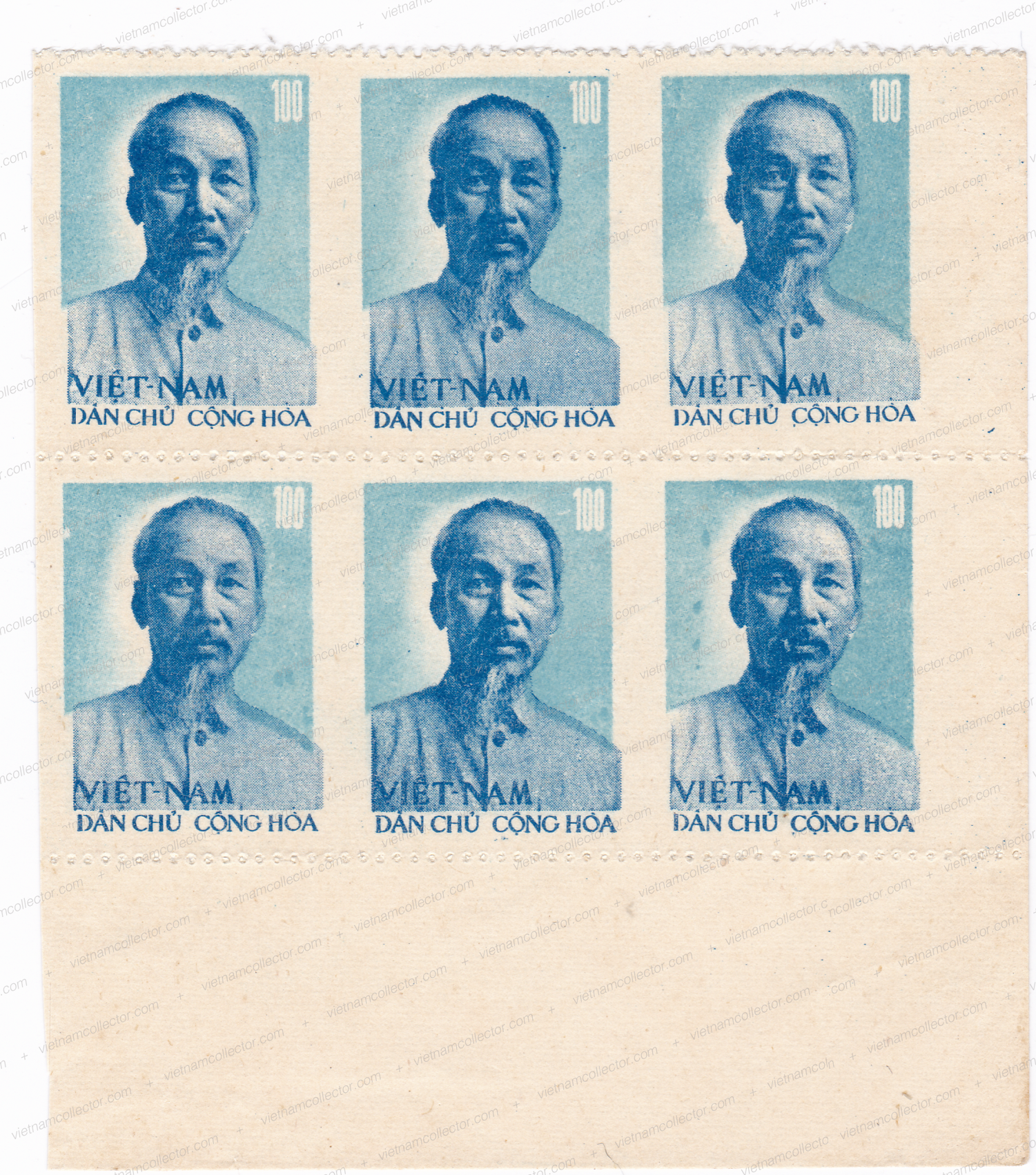
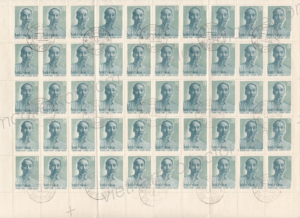
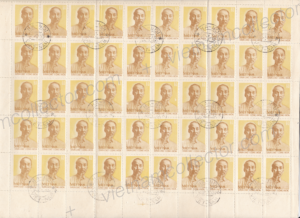
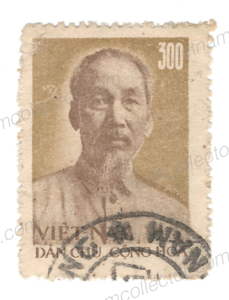
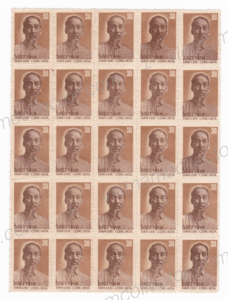
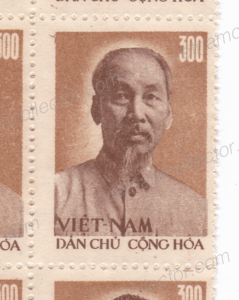
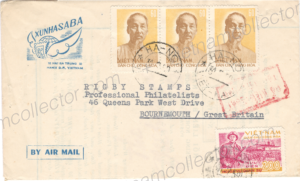

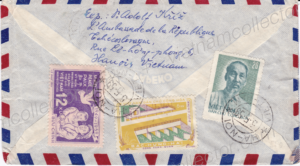
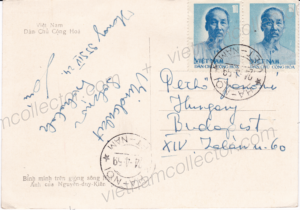
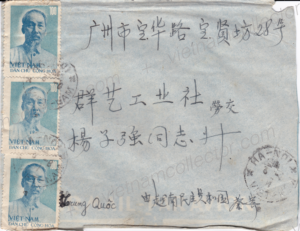
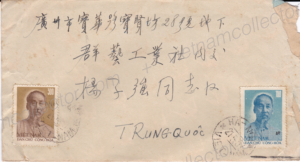
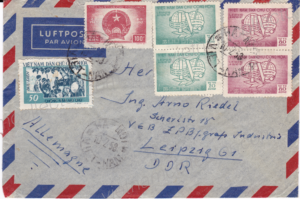
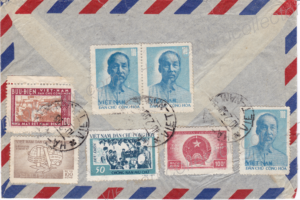
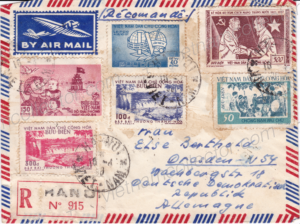
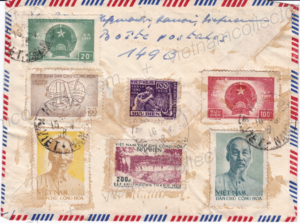
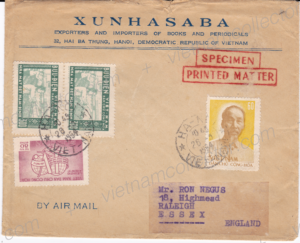
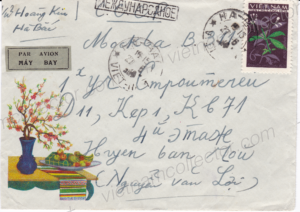
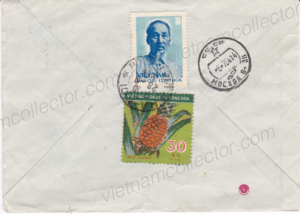
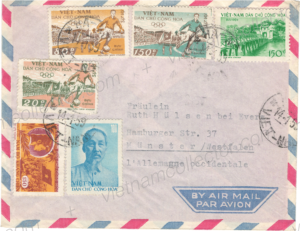
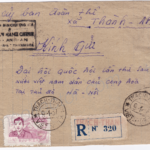
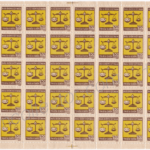
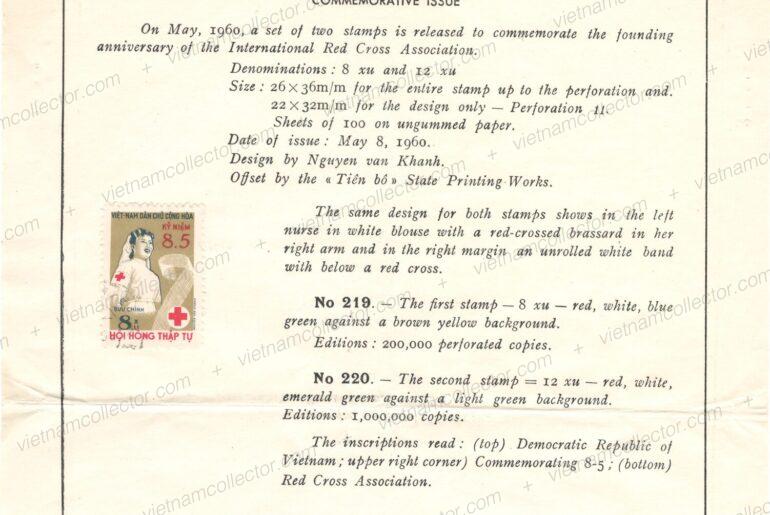
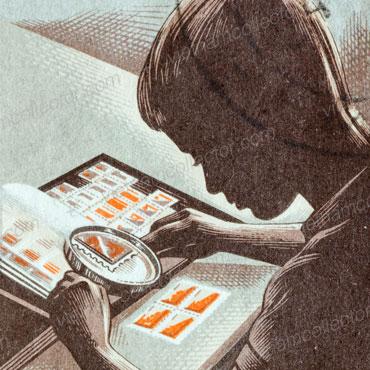
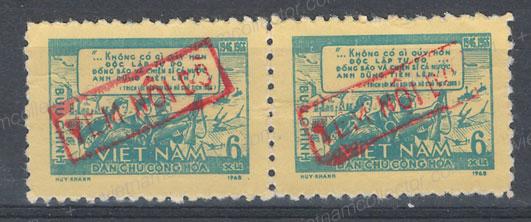
Comments are closed.